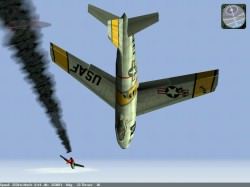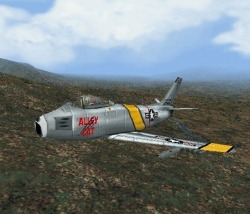|
How to Keep Your Wings Attached and Trousers Dry by David Lian |
||||
|
Quite some time ago David wrote a flight training briefing for us on Spins. This is a followup to his earlier work. You're at 30,000ft, on your first mission, escorting B-29s deep into North Korean airspace. Sunlight glints off the wings of MiG-15s rolling in from above. As they come screaming in, you wonder if you'll meet a Russian instructor from "Antung University" or one of the freshmen today. Turning hard into the MiGs while staying with your lead, he calls, "I'm padlocked!" Checking around, you pick up four MiGs bearing down from the opposite direction to the first group. You call, "Viper lead, not clear!" just as the lead MiG fires. Too late, Viper Lead is hit and loses his tail feathers. He ejects and you make a "May Day" call for him. Time to get out. Single birds are dead meat in MiG Alley. The victorious lead MiG begins reversing his pass as you roll into a steep right hand descending turn to head home. Anxiously checking your six, the lead MiG is now bearing down on you. Instinctively, you continue into a high-speed, high-G defensive spiral to shake him off. He stays with you. So now you know - you've met an instructor from Antung University!
 25,000...21,000...17,000...the altimeter continues winding down merrily. Checking the G-meter, you see and feel all of the 8.5Gs. You know your bird is feeling the Gs as well - it's that funny groaning sound from the airframe! Your breathing is difficult and heaving, your sight is greying and tunnelling...9,000ft and still falling - time to recover. You roll hard back to your left while continuing to pull hard on the stick. BANG! Happy lawn darting because you've just lost your right wing! |
 MiG Alley Huh? Welcome to the new world of structural failure modelling in flight sims. PCs and sim codes have now become sufficiently fast and sophisticated to simulate such realities. Sims like MiG Alley certainly provide a rude shock to those PC fighter jocks who have a habit of heavy-handed stick hauling. No fancy fly-by-wire G-limiters to molly coddle you. Time to rediscover the light touch or life will get short for heavy-handed yank and bank jocks! A Question of Factors First, a little terminology to square away. Most accelerometers (G-meters) in non-zillion dollar aircraft, measure load factor (G) along the aircraft centreline. The maximum value shown on the meter is typically called the limit load factor or maximum G. So why don't you hear the dreaded explosive failure when you pull the maximum G? Without going into a lengthy discussion about limit and ultimate/design load factors, the short answer is that the maximum G is not the calculated failure load factor of the airframe. The ultimate or design load factor is the point at which failure is expected. Its value is 1.5 times the limit load factor or maximum G. The 1.5 multiple is known as the factor of safety; and is a deliberate reserve buffer. So for example, if the limit load factor is 6G, then the ultimate load factor is 9G (6G x 1.5). In MiG Alley, the F-86 accelerometer shows 9G as the maximum value (ie limit load factor) which means that the theoretical ultimate load factor is 13.5G (9G x 1.5). In practice, as an airframe ages, its ability to withstand load factors up to the original design specification becomes increasingly doubtful. Go to Part II
|
|||
|
Copyright © 1997 - 2000 COMBATSIM.COM, INC. All Rights Reserved. Last Updated November 22nd, 1999 |
||||
